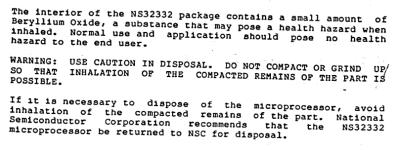I was disassembling an Apple IIGS power supply with a rather unusual design where the heatsink is mated to the housing with thermal compound in between. Removing the circuit board from the enclosure exposes the compound. Normally I wouldn't think anything of this, but I recalled safety warnings on minuszerodegrees.net including one stating that "In old power supplies, the thermal paste used between semiconductors and heatsinks, typically contained beryllium oxide (BeO). Beryllium oxide is known to be carcinogenic."
I had heard about beryllium in magnetrons and very old fluorescent lamps, but was surprised it might be found in personal computers. Sure if it's in a solid form or encapsulated there's little risk, but it's fairly easy to come into contact with thermal compound while performing routine repairs. Were beryllium-based compounds really commonplace in the 1980s or might they have been less typical than minuszerodegrees suggests?
With fluorescent lamps, beryllium silicate phosphor could be released into the air during production or when a tube was broken, which is why manufacturers had changed to a beryllium-free alternative by 1950. My inclination is that if beryllium oxide thermal paste was in fact employed decades after the hazards were known, it must be a relatively safe form. Do any of you know if this stuff was actually made with beryllium and if it was, is it unlikely to degrade in a way that could release airborne particles when disturbed? I'd certainly hope it's not an issue, considering that airborne beryllium has been known to cause disease even in small quantities.
Searching the web I found only a handful of posts related to the topic, which were not all consistent regarding the prevalence and safety of BeO in thermal compound. I'm wondering what kind of precautions people ought to be taking when it's necessary to remove or otherwise disturb old compound.
I had heard about beryllium in magnetrons and very old fluorescent lamps, but was surprised it might be found in personal computers. Sure if it's in a solid form or encapsulated there's little risk, but it's fairly easy to come into contact with thermal compound while performing routine repairs. Were beryllium-based compounds really commonplace in the 1980s or might they have been less typical than minuszerodegrees suggests?
With fluorescent lamps, beryllium silicate phosphor could be released into the air during production or when a tube was broken, which is why manufacturers had changed to a beryllium-free alternative by 1950. My inclination is that if beryllium oxide thermal paste was in fact employed decades after the hazards were known, it must be a relatively safe form. Do any of you know if this stuff was actually made with beryllium and if it was, is it unlikely to degrade in a way that could release airborne particles when disturbed? I'd certainly hope it's not an issue, considering that airborne beryllium has been known to cause disease even in small quantities.
Searching the web I found only a handful of posts related to the topic, which were not all consistent regarding the prevalence and safety of BeO in thermal compound. I'm wondering what kind of precautions people ought to be taking when it's necessary to remove or otherwise disturb old compound.


